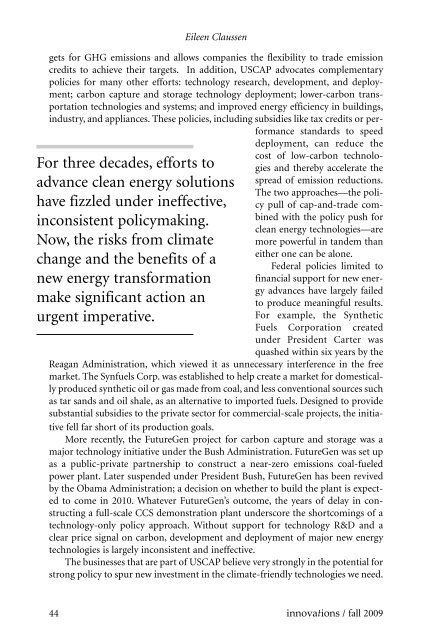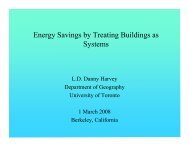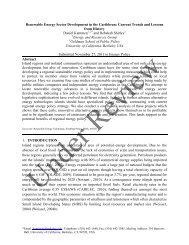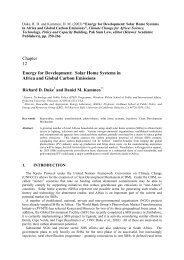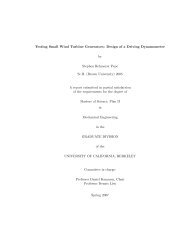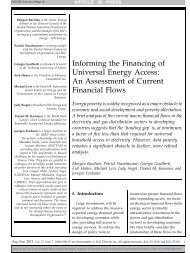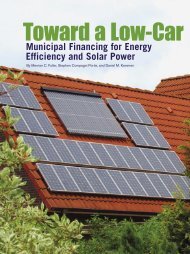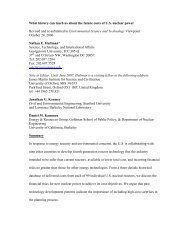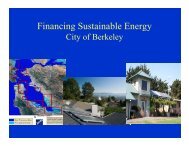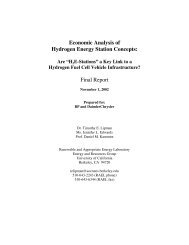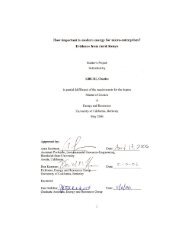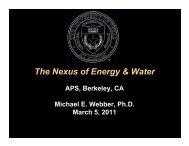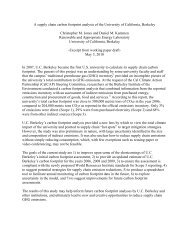Innovations, Energy for Change, Fall 2009.pdf - Renewable and ...
Innovations, Energy for Change, Fall 2009.pdf - Renewable and ...
Innovations, Energy for Change, Fall 2009.pdf - Renewable and ...
You also want an ePaper? Increase the reach of your titles
YUMPU automatically turns print PDFs into web optimized ePapers that Google loves.
Eileen Claussen<br />
gets <strong>for</strong> GHG emissions <strong>and</strong> allows companies the flexibility to trade emission<br />
credits to achieve their targets. In addition, USCAP advocates complementary<br />
policies <strong>for</strong> many other ef<strong>for</strong>ts: technology research, development, <strong>and</strong> deployment;<br />
carbon capture <strong>and</strong> storage technology deployment; lower-carbon transportation<br />
technologies <strong>and</strong> systems; <strong>and</strong> improved energy efficiency in buildings,<br />
industry, <strong>and</strong> appliances. These policies, including subsidies like tax credits or per<strong>for</strong>mance<br />
st<strong>and</strong>ards to speed<br />
deployment, can reduce the<br />
For three decades, ef<strong>for</strong>ts to<br />
advance clean energy solutions<br />
have fizzled under ineffective,<br />
inconsistent policymaking.<br />
Now, the risks from climate<br />
change <strong>and</strong> the benefits of a<br />
new energy trans<strong>for</strong>mation<br />
make significant action an<br />
urgent imperative.<br />
cost of low-carbon technologies<br />
<strong>and</strong> thereby accelerate the<br />
spread of emission reductions.<br />
The two approaches—the policy<br />
pull of cap-<strong>and</strong>-trade combined<br />
with the policy push <strong>for</strong><br />
clean energy technologies—are<br />
more powerful in t<strong>and</strong>em than<br />
either one can be alone.<br />
Federal policies limited to<br />
financial support <strong>for</strong> new energy<br />
advances have largely failed<br />
to produce meaningful results.<br />
For example, the Synthetic<br />
Fuels Corporation created<br />
under President Carter was<br />
quashed within six years by the<br />
Reagan Administration, which viewed it as unnecessary interference in the free<br />
market. The Synfuels Corp. was established to help create a market <strong>for</strong> domestically<br />
produced synthetic oil or gas made from coal, <strong>and</strong> less conventional sources such<br />
as tar s<strong>and</strong>s <strong>and</strong> oil shale, as an alternative to imported fuels. Designed to provide<br />
substantial subsidies to the private sector <strong>for</strong> commercial-scale projects, the initiative<br />
fell far short of its production goals.<br />
More recently, the FutureGen project <strong>for</strong> carbon capture <strong>and</strong> storage was a<br />
major technology initiative under the Bush Administration. FutureGen was set up<br />
as a public-private partnership to construct a near-zero emissions coal-fueled<br />
power plant. Later suspended under President Bush, FutureGen has been revived<br />
by the Obama Administration; a decision on whether to build the plant is expected<br />
to come in 2010. Whatever FutureGen’s outcome, the years of delay in constructing<br />
a full-scale CCS demonstration plant underscore the shortcomings of a<br />
technology-only policy approach. Without support <strong>for</strong> technology R&D <strong>and</strong> a<br />
clear price signal on carbon, development <strong>and</strong> deployment of major new energy<br />
technologies is largely inconsistent <strong>and</strong> ineffective.<br />
The businesses that are part of USCAP believe very strongly in the potential <strong>for</strong><br />
strong policy to spur new investment in the climate-friendly technologies we need.<br />
44 innovations / fall 2009


